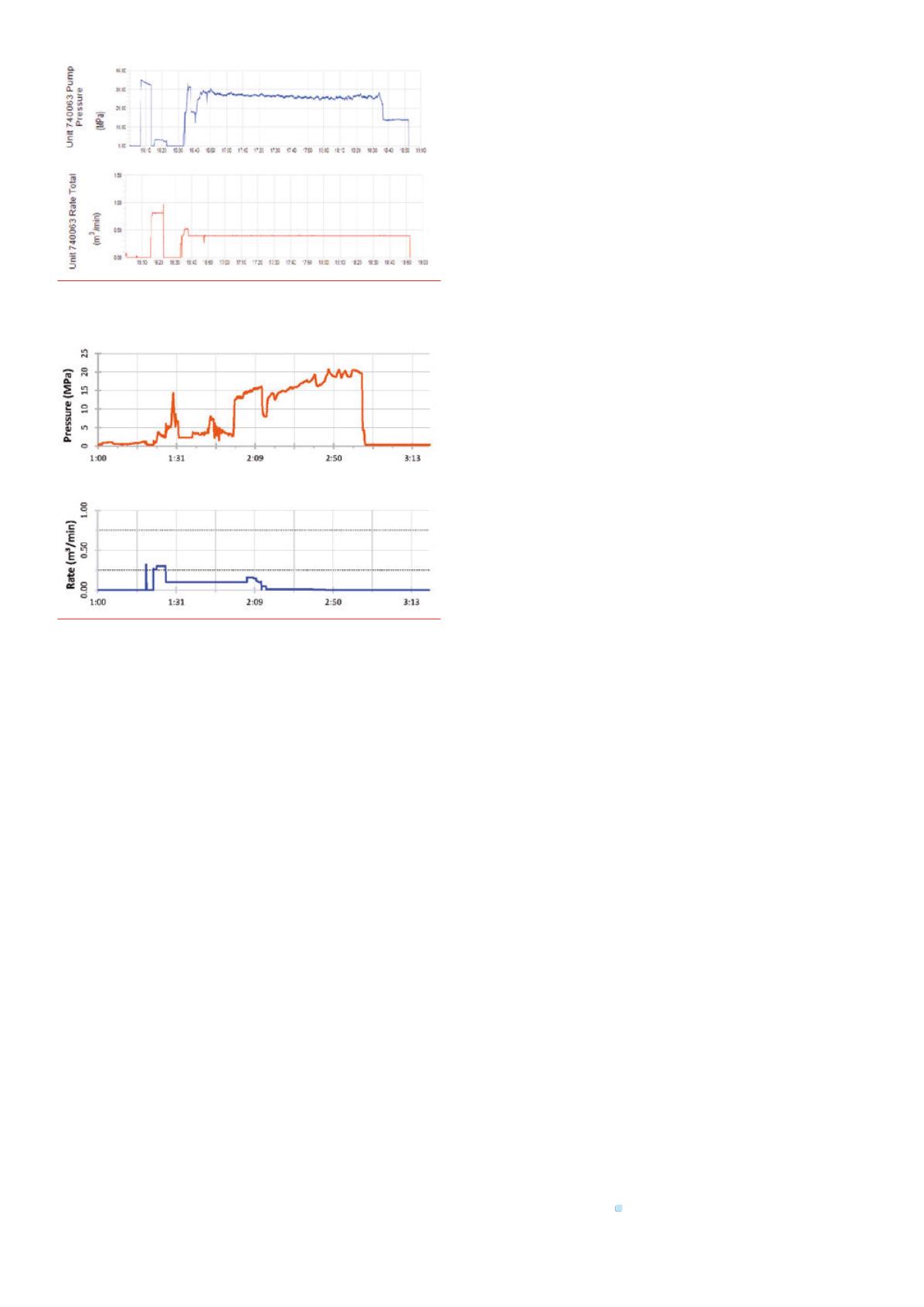
58 |
Oilfield Technology
June
2015
may occur. The feed rate and corresponding pressure response will
be used to design an appropriate treatment. When abrasive jetting
has been used to intercept annular gas flow the feed rate tends to be
relatively low.
Step4:Designingthe job
Recommended solutions may involve circulation, bradenhead,
retainer, or even two blend retainer squeezes. Depending on the
well conditions, hesitation or continuous low rate squeezing are
recommended. In some cases, using a hesitation method will reduce
slurry setting times and promote gel strength development. The
pressure response is monitored throughout slurry injection until
a flat‑line pressure response is observed. When using a slow rate
continuous squeeze method, the squeeze schedule is based on
squeezing cement until the final thickening time. Application of
continuous squeeze pressure until cement sets impairs the ability
of gas to permeate the slurry matrix, while promoting isolation of
zones with more restricted flow paths. This is the preferred method; it
requires a low rate pumper capable of pumping at volumes as low as
2 l/min. This technique allows for the use of smaller product volumes,
and squeezing near or slightly above the formation fracture limit
across the shallow zones.
Step5: Selectingtherightproducts
Feed rates are often low or restricted where abrasive jetting has
been used. Conventional or specialised squeeze cementing systems
may be required. Where restricted feed rates are observed, acid
treatments may be required to improve communication to the
zone of interest. Typical cement additive packages include friction
reducers to reduce viscosity, improving flow into the formation
matrix, and polymers to reduce filtrate loss as the cement is
subjected to differential pressure throughout squeezing. This reduces
premature slurry dehydration, and improving slurry penetration.
Experience gained in Western Canadian formations, has shown
that the incorporation of microfine cement improves the chances of
successfully isolating shallow gas sources. Even in formations where
the feed rate was not an issue some operators got better results
by using the microfine cement as a lead and tailing in with regular
class G cement.
Casestudy:NortheasternBritishColumbiawells
withsurfacecasingvent flowissues
Surface casing vent flows (SCVF) in northeastern British Columbia
have presented considerable challenges for E&P companies. As a
result of the low permeability and the high formation pressures
observed in the area, conventional perforating and cement squeeze
methods have not been overly successful in eliminating gas migration
and vent flows at the surface.
One of the most problematic aspects of repairing a SCVF is
placing the cement treatment into the target zones. These target
zones are difficult to access with cement due to very tight cap rock
formations and the high pressure required to initiate a cement
squeeze, without exceeding fracture pressure.
To combat the problems associated with eliminating SCVF using
traditional interventions, Sanjel customised a different remediation
approach in northeastern British Columbia. By using hydraulic
abrasive jetting combined with a slow rate squeeze technique
and utilising one or multiple cement blends to seal off the zone,
the company was able to successfully eliminate gas migration in a
number of clients’ wells. The remediation process that has proven
most successful, involves cutting slots along the horizontal plane to
achieve communication with the adjacent formation to obtain 360˚
borehole coverage and subsequently perform a pinpoint treatment
cement squeeze.
As previously demonstrated in northeastern British Columbia
by the numerous wells worked over, the injection rate is often
relatively low at the maximum allowable pump pressure. Cutting
horizontal slots through casing cement and into the rock allows
adequate exposure to the formation and creates enough room
to place cement. The operation was achievable by erosive action
of high velocity flow rates through the jets using abrasive fluid
containing material such as sand. The abrasive jetting cutting
process is illustrated in Figure 2.
Sanjel’s Slow Rate Pumping Unit (SRPU) was utilised to
continuously squeeze cement until maximum pressure was achieved.
The SRPU controls rates and pressures to inject the slurry into any
available voids without fracturing additional areas. Micro‑fine cement
designed specifically for the extreme low feed rates was forced
through the slots at various rates as low as 2 l/min at 20 MPa squeeze
pressure (Figure 3). Subsequently, cement was placed around
the casing like a pancake, into small channels as well as into any
extending fractures until the thickening time was reached to intercept
and block any gas migration.
Conclusion
Existing SCVF challenges in northeastern British Columbia were
overcome by deviating from conventional techniques and employing
a combination of hydraulic abrasive jetting and slow rate squeeze
techniques. This customised solution has allowed clients to repair a
number of problematic existing wells while saving money, rig time
and job servicing costs.
Figure 2.
Well schematic demonstrating hydraulic abrasive jetting
taken froma typical job.
Figure 3.
Detaining slow rate retainer squeeze on one typical well.


